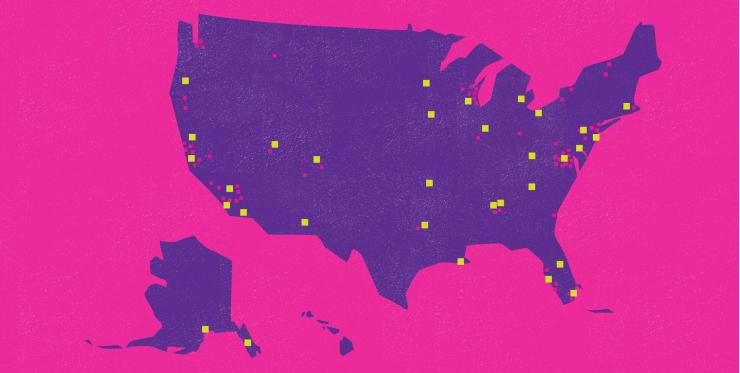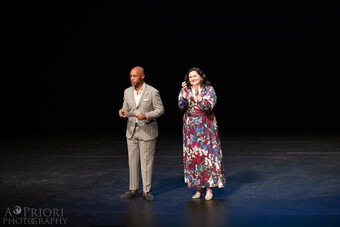Networks and New Works
NNPN Turns Twenty
We’re celebrating the twentieth anniversary of the founding of the National New Play Network (NNPN) with a season of reflection and planning. I am proud to have watched as NNPN grew from a small, informal group of determined new works theatremakers to a much-lauded service organization that has fundamentally changed how new plays are created, shared, discovered, produced, and propagated. The success of the Network, its members, its Affiliated Artists, and its programs is due in large part to the group’s focus on turning competitors into colleagues and colleagues into collaborators.
I like to explain it like this: the networking part of the Network is what makes the Network work.
[W]e know that working together is how impactful innovations are created.
You see, from the beginning NNPNers believed that the concept of theatres as competitors was harmful to the field, and the founders set about proving that if you give theatremakers a chance to collaborate, better theatre will result. Now, twenty years into an NNPN-led revolution, the new play world has a greater understanding of the impact of collaboration. We know for certain that collaboration allows the introduction of different voices to new communities, brings diversity to all markets, raises the profiles of theatres and artists in their hometowns and across the country, and creates a solid support system for new work.
And we know that working together is how impactful innovations are created.
The Network began by setting up forms of communication that allowed its members to meet and get to know each other and the artists and plays they admired. The founding members created programs to combat the field’s focus on the concept that the only production that mattered was the first (“premiere-itis”) and the perceived importance of New York-generated programming, and to remedy the lack of a pipeline for sharing works created outside of the nation’s theatre centers.
Bi-annual in-person membership meetings featuring readings of new works, sessions on best practices, and visioning discussions about the issues plaguing the field were added and have become standard. To incentivize and make regular attendance at in-person meetings possible, the Network provides travel reimbursement for one leader from each Core Member theatre. These convenings are supplemented by online position-specific quarterly conversations for Member theatre’s staffs and literary pitch session via email, phone, and in person. These multiple opportunities to convene quickly led to formalized partnerships and collaborations.
NNPN’s Rolling World Premiere program is a unique model that shattered the mold of "Development Hell”—ongoing workshops and readings that never result in a fully-realized rehearsal process and performances—by lining up multiple productions for a play before it ever begins rehearsals. NNPN provides support for a partnership when three or more Member theatres agree to work with a playwright to mount separate and distinct productions of a new play within a twelve-month period. The idea of giving theatres of different budgets and sizes money to work together on a previously unproduced play, allowing the playwright to continue to develop the work in front of often vastly different audiences, was revolutionary. Now seventy-five plays have been through the program, playwrights have had their careers created or strengthened, theatres across the country have gained a national profile, and these supported works have received hundreds of subsequent productions.

With the advent of the Rolling World Premiere program, NNPN proved that sharing works and writers do not devalue them it; it gives playwrights multiple chances to experiment and reach the artistic completion that results from second and third productions. Artist, audience, and critical responses to the play allow the playwright to continue to revise and strengthen the work along the Roll, and Member Theatres bring new but tested work to their audiences, providing new ideas and input at the play’s every stop.
This program led to the creation of more opportunities for the Membership to work together. The National Showcase of New Plays was formalized and now brings the entire NNPN community together to see readings of new plays nominated, adjudicated, and selected by its Member Theatres. The MFA Playwrights Workshop (a partnership between NNPN, The Kennedy Center’s American College Theatre Festival, and The Stanford Center for New Plays) has served as a career-building bridge for more than forty student writers. Commissions for emerging writers, residencies for producers, and fellowships for directors introduce early career, emerging, and transitioning theatre professionals to the Network. NNPN moderates affinity group conversations and in-person meetings for its Membership’s leaders, the alumni of its programs, and its Ambassadors—artists, patrons, and other interested industry professionals recommended by the Membership to help others understand the mission and purpose of NNPN—to discuss topics of interest to the Network and the field.
NNPN’s desire to continue to shape and serve the field has not slowed, and the successes of the Network’s initiatives have bred a desire for more, for 'what’s next?' and 'what else?'
Member-governed and member-driven, NNPN’s Core Members, now thirty in number, make up our Board of Directors and drive our programming. These theatres have missions that prioritize new work and are committed to collaborating with each other.
In 2012, we added Associate Memberships, available to both smaller and larger companies with proven interest and investment in producing new works. This expansion and diversification increased NNPN’s ability to respond to field-wide questions and generate new ideas to enhance the ways that theatres and theatres makers interact.
NNPN’s desire to continue to shape and serve the field has not slowed, and the successes of the Network’s initiatives have bred a desire for more, for “what’s next?” and “what else?”
In 2015, after nearly two years of nation-wide research, development, and testing, we launched the game-changing New Play Exchange (NPX). This powerful database has provided an extraordinary new path for the discovery and sharing of works by living writers. Designed by and for the field, NPX enables generative artists to upload plays and musicals so that those seeking to read and produce new works can find them. This crowd-sourced, cloud-based mechanism for new play disbursement is bringing the power of technology to the problem of submission policy, literary management, and season planning and affecting thousands of theatres and theatremakers around the world.
The Network’s commitment to the future of the field continues, and I find that most exciting. Last year we partnered on a research project to develop a better understanding of the audiences that seek out, find, see, and engage with plays and playwrights that are unfamiliar to them. The Triple Play study, conducted by Theatre Development Fund and Theatre Bay Area with the assistance of NNPN’s Membership, is the largest data grab ever about how single ticket buyers interact with new work. Many of its conclusions are counter to current industry practices and may change how we think of season planning, marketing, and audience engagement around the works of contemporary writers in a post-subscription-dependent theatrical environment.
Although its Membership is restricted to US-based companies, the Network has developed work internationally, with playwright swaps with Australia and Canada, and workshops in Mexico. NPX currently includes profiles of theatremakers in almost fifty countries. One exciting new initiative, International Women’s Voices Day, is happening on 21 January in celebration of the anniversary of the beginning of another revolution: the Women’s Marches. This collaboration between NNPN, the New Play Exchange, and the DC-area Women’s Voices Theatre Festival (for which I serve as Coordinating Producer) encourages theatremakers over the world to read aloud unproduced plays by women writers.
In December 2017, NNPN held its largest gathering ever of new play leaders—the 2017 National Showcase of New Plays—and the consensus was that the weekend of meetings, conversations, readings, and collegiality was as exciting as that first session must have been twenty years ago. We began working on a new strategic plan for the future, one with that will begin with a restatement of the fundamental importance of new works, have a commitment to equity, diversity, and inclusion at its center, and determine the next ”big question” that NNPN will seek to answer for the field.
I and the one hundred and seventy-five Member Theater representatives, Affiliated Artists, Ambassadors, and new play supporters came away with a revived sense of the power of a collective effort, a renewed dedication to collaboration, and the networking part of the Network.
Because that is what makes the Network work.
And what turns competitors into colleagues, and colleagues into artists who want to come together to make new works for today’s audiences and revolutionary, impactful innovations for theaters and theater-makers around the world.
So here’s to another twenty years of collaborations, of relationships created and nourished, of information gathered and innovations launched. Here’s to more new works for the nation and the world.
And here’s to the Networking part of the Network working again and again.
Happy anniversary, NNPN!









Comments
The article is just the start of the conversation—we want to know what you think about this subject, too! HowlRound is a space for knowledge-sharing, and we welcome spirited, thoughtful, and on-topic dialogue. Find our full comments policy here